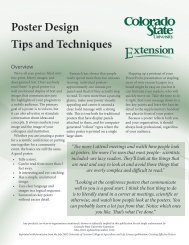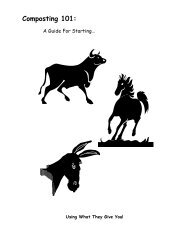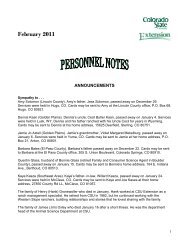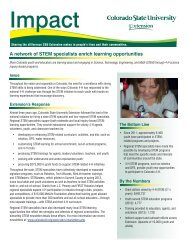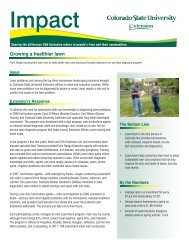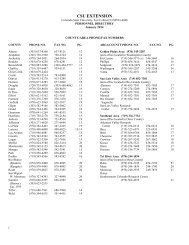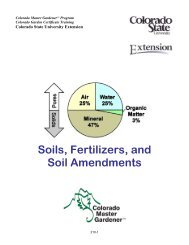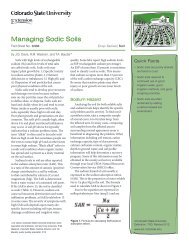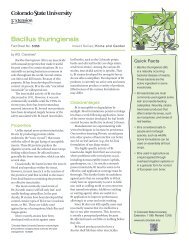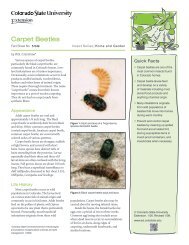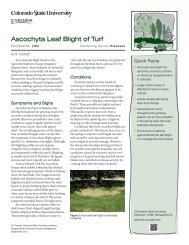Irrigation Water Quality Criteria - Colorado State University Extension
Irrigation Water Quality Criteria - Colorado State University Extension
Irrigation Water Quality Criteria - Colorado State University Extension
You also want an ePaper? Increase the reach of your titles
YUMPU automatically turns print PDFs into web optimized ePapers that Google loves.
Table 2. Potential yield reduction from saline water for selected irrigated crops. 1<br />
% yield reduction<br />
Crop 0% 10% 25% 50%<br />
————————— EC w2<br />
—————————<br />
Barley 5.3 6.7 8.7 12<br />
Wheat 4.0 4.9 6.4 8.7<br />
Sugarbeet 3 4.7 5.8 7.5 10<br />
Alfalfa 1.3 2.2 3.6 5.9<br />
Potato 1.1 1.7 2.5 3.9<br />
Corn (grain) 1.1 1.7 2.5 3.9<br />
Corn (silage) 1.2 2.1 3.5 5.7<br />
Onion 0.8 1.2 1.8 2.9<br />
Dry Beans 0.7 1.0 1.5 2.4<br />
1<br />
Adapted from “<strong>Quality</strong> of <strong>Water</strong> for <strong>Irrigation</strong>.” R.S. Ayers. Jour. of the Irrig. and Drain. Div., ASCE.<br />
Vol 103, No. IR2, June 1977, p. 140.<br />
2<br />
EC w<br />
= electrical conductivity of the irrigation water in dS/m at 25 o C.<br />
3<br />
Sensitive during germination. EC w<br />
should not exceed 3 dS/m for garden beets and sugarbeets.<br />
Table 3. Conversion factors for irrigation water quality laboratory reports.<br />
To Multiply To<br />
Component Convert By Obtain<br />
<strong>Water</strong> nutrient or TDS mg/L 1.0 ppm<br />
<strong>Water</strong> salinity hazard 1dS/m 1.0 1mmho/cm<br />
<strong>Water</strong> salinity hazard 1mmho/cm 1,000 1 µmho/cm<br />
<strong>Water</strong> salinity hazard EC w (dS/m) 640 TDS (mg/L)<br />
for EC 5 dS/m<br />
<strong>Water</strong> NO 3 N, SO 4 -S, B applied ppm 0.23 lb per acre inch<br />
of water<br />
<strong>Irrigation</strong> water acre inch 27,150 gallons of water<br />
Table 4. Guidelines for assessment of sodium hazard of irrigation water based on SAR and<br />
EC w2<br />
.<br />
________________________________________________________________________________________________________________________________________________________<br />
Potential for <strong>Water</strong> Infiltration Problem<br />
<strong>Irrigation</strong><br />
water SAR Unlikely Likely<br />
2<br />
-----------EC w<br />
(dS/m)----------<br />
0-3 > 0.7 < 0.2<br />
3-6 > 1.2 < 0.4<br />
6-12 > 1.9 < 0.5<br />
12-20 > 2.9 < 1.0<br />
20-40 > 5.0 < 3.0<br />
________________________________________________________________________________________________________________________________________________________<br />
2<br />
Modified from R.S. Ayers and D.W. Westcot. 1994. <strong>Water</strong> <strong>Quality</strong> for Agriculture, <strong>Irrigation</strong> and<br />
Drainage Paper 29, rev. 1, Food and Agriculture Organization of the United Nations, Rome.<br />
Table 5. Susceptibility ranges for crops to foliar injury from saline sprinkler water.<br />
Na or Cl concentration (mg/L) causing foliar injury<br />
Na concentration 460<br />
Cl concentration 700<br />
Apricot Pepper Alfalfa Sugarbeet<br />
Plum Potato Barley Sunflower<br />
Tomato Corn Sorghum<br />
Foliar injury is influenced by cultural and environmental conditions. These data are presented<br />
only as general guidelines for daytime irrigation. Source: Mass (1990) Crop salt tolerance. In:<br />
Agricultural Assessment and Management Manual. K.K. Tanji (ed.). ASCE, New York. pp. 262-304.<br />
Definitions<br />
Abbrev. Meaning<br />
mg/L milligrams per liter<br />
meq/L milliequivalents per liter<br />
ppm parts per million<br />
dS/m deciSiemens per meter<br />
µS/cm microSiemens per<br />
centimeter<br />
mmho/cm millimhos per centimeter<br />
TDS total dissolved solids<br />
Factors influencing yield reductions include<br />
soil type, drainage, salt type, irrigation<br />
system and management.<br />
The amount of water transpired through<br />
a crop is directly related to yield; therefore,<br />
irrigation water with high EC w<br />
reduces<br />
yield potential (Table 2). Beyond effects on<br />
the immediate crop is the long term impact<br />
of salt loading through the irrigation<br />
water. <strong>Water</strong> with an EC w<br />
of 1.15 dS/m<br />
contains approximately 2,000 pounds of<br />
salt for every acre foot of water. You can use<br />
conversion factors in Table 3 to make this<br />
calculation for other water EC levels.<br />
Other terms that laboratories and<br />
literature sources use to report salinity<br />
hazard are: salts, salinity, electrical<br />
conductivity (EC w<br />
), or total dissolved solids<br />
(TDS). These terms are all comparable<br />
and all quantify the amount of dissolved<br />
“salts” (or ions, charged particles) in a<br />
water sample. However, TDS is a direct<br />
measurement of dissolved ions and EC<br />
is an indirect measurement of ions by<br />
an electrode.<br />
Although people frequently confuse<br />
the term “salinity” with common table salt<br />
or sodium chloride (NaCl), EC measures<br />
salinity from all the ions dissolved in a<br />
sample. This includes negatively charged<br />
ions (e.g., Cl¯, ) and positively charged<br />
NO¯3<br />
ions (e.g., Ca ++ , Na + ). Another common<br />
source of confusion is the variety of unit<br />
systems used with EC w<br />
. The preferred unit<br />
is deciSiemens per meter (dS/m), however<br />
millimhos per centimeter (mmho/cm) and<br />
micromhos per centimeter (µmho/cm)<br />
are still frequently used. Conversions to<br />
help you change between unit systems are<br />
provided in Table 3.



